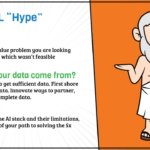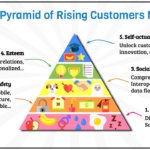An impending recession, the AI/ML gold rush, Data as the new oil, SaaS Explosion…
The SaaS landscape is changing rapidly and so are the customer expectations!
18 months ago, I came across a message that India is a premier hub for global B2B SaaS, just like Israel is a hub for cybersecurity. At first, I did not think much of it, but after having interacted with many SaaS founders and observing their painful growth journey, I realized the potential in these words. Yet, a series of market shifts are changing the world order of SaaS putting at test India’s position as a premier hub for SaaS.
TL;DR
The SaaS 3.0 market shifts are changing how global customers perceive value from SaaS products:
- Tools which provide higher levels of automation & augmentation are valued more.
- Comprehensive solutions in place of single point products is a preference.
- Interoperability across the gamut of systems is an expected norm.
Startups, you have to build your new orbit to solve for these evolving needs. First, focus on delivering a 5x increase in customer value through an AI-enabled proposition. Next, build your proprietary data pot of gold, which can also serve as a sustainable moat. Lastly, leverage platforms & partnerships to offer a suite of products and solve comprehensive customer scenarios.
Read more on how the convergence of market shifts are impacting SaaS 3.0.
Quick background
 While the SaaS industry began over 2 decades ago, many say it is only now entering the teenage years. Similar to the surge of hormones which recently brought my teenage daughter face-to-face with her first pimple. And she is facing a completely new almost losing battle with creams and home remedies. In the same vein, convergence of several market shifts – technology, data, economics, geopolitics – combined with deep SaaS penetration is evolving the industry to a new era. This rare convergence – like the convergence of the nine realms in Thor Dark World – is also rapidly changing how customers perceive the capability of SaaS products.
While the SaaS industry began over 2 decades ago, many say it is only now entering the teenage years. Similar to the surge of hormones which recently brought my teenage daughter face-to-face with her first pimple. And she is facing a completely new almost losing battle with creams and home remedies. In the same vein, convergence of several market shifts – technology, data, economics, geopolitics – combined with deep SaaS penetration is evolving the industry to a new era. This rare convergence – like the convergence of the nine realms in Thor Dark World – is also rapidly changing how customers perceive the capability of SaaS products.
Convergence #1 – SaaS penetration is exploding!

I learned from Bala at Techstars India that they received a record number of applications for their first accelerator program. 60% of these were building or ideating some form of B2B SaaS offering. It would seem to justify the message above, that SaaS in India has grown legs, building a true viral movement, replicating momentum. Yet in these large numbers, there is also a substantial ratio of repetitive products to innovations. Repetitive in say building yet another CRM, or mindlessly riding a trend wave such as chatbots. Without an increased pace of innovation beyond our existing successes, we cannot continue to be a premier hub.
In 2018 SaaS continued to be the largest contributor to cloud revenue growth at 17.8% (it was down from 20.2% in 2017). Competition is heating up in all categories of SaaS. 10 years ago, an average SME customer was using 2 apps, now it averages at 16 apps. 5 years ago, a SaaS startup had on average 3 competitors, now a SaaS startups averages at 10 customers right out the door. Many popular SaaS categories are “Red Oceans”. Competing in these areas is typically on the basis of features or price, dimensions which are easy for any competition to catch up on. There is a need for startups to venture deeper into the sea and discover unserved & unmet customer needs in a “Blue Ocean” where they have ample opportunity to fish and build a sustainable moat.
AppZen started with an opportunity to build conversational chatbots for employees, helping them in an enterprise workflows on various aspects like sales & expenses, and several other companies are doing the same. But as they went deeper to understand the customer pains, they were able to identify an unserved need and pivoted, leveraging the same AI technology they had built, to solve for T&E expense auditing. Being a first mover to solve this problem, they are carving out leadership in this underserved space and is one of the fastest growing SaaS startups of 2018.
Convergence #2 – Impending recession in 2019/2020!

On average recessions come every four years and we are currently 9 years from the last recession. The war between the Fed vs the US govt on interest rates, the recent US govt shutdown on a frivolous $B wall, the tariff and trade war between the US and China, are all indicative reasons for an upcoming recession. In such an uncertain economy, customers experience reduced business activity and alter their behavior and preferences:
- Customers will become crystal clear about satisfying their core needs versus nice-to-haves.
- They will seek high automation tools to help not only cut costs but also to make strategic decisions for an upside.
- Many will prefer a suite of tools instead of buying multiple single point products.
- They will also slow down POC, investment, partnership activities.
In a way, this is mixed news. Companies often pursue low-cost digital products with SaaS being a natural choice. However, combined with the competitive SaaS landscape, businesses become very selective. To be recession-proof startups must:
- Collaborate and partner with other vendors to build a shared view of the larger customer scenarios. Innovate to share (anonymized) data/intelligence.
- Partner to deliver a comprehensive solution instead of solving for a gap.
- Invest & experiment in building solid AI-enabled automation for improving efficiency and decision making.
E.g. Clearbit’s approach to provide API and allow customers to leverage the value it provides, by integrating with common platforms such as Slack or Gmail which customers frequently use. In this approach they are reducing app switching and embedding the niche usecase into the larger customer workflow environment.
Another e.g. Tact.ai is helping increase sales team efficiency and bring visibility of field data to the leadership team. They are not only solving the core salesforce data entry problem for field sales, but with better data in the system, businesses now get better visibility about sales activities and can take effective strategic decisions.
Convergence #3 – the AI/ML gold rush!

During the dot com & mobile rush in early 2000, I watched many a friend jump ship to build a startup. At that time the web was flush with rich content, but the mobile web was in its early growth and innovative ways to bring web content onto mobile phones were being explored. Automated conversion of HTML to WML was a hot topic. But the ecosystem conditions were not aligned for completely automated WML transformations. Several startups in this space including my friend’s startup shut for such reasons.
More recently in 2016-17 Chatbots were projected to be the next big thing and it too suffered from similar misalignment. Chatbots were the first attempt to bring AI/NLP for customer interaction. However, they lacked the depth of ecosystem conditions to make them successful.
- Bots were treated as a panacea for all kinds of customer interactions and were blindly applied to problems. 70% of the 100,000+ bots on Facebook Messenger fail to fulfill simple user requests. This is partly a result of not focusing on one strong area of focus for user interaction.
- Bots were implemented with rule-based dialogues, there was no conversational design built into it. NLP is still in its infancy and most bots lacked data to provide meaningful interactions. They were purely a reflection of the level of detail and thought that went into the creation of the bots.
AI/ML, however, is suffering from the “hype” of an “AI/ML hype”. There is a considerable depth within the AI/ML ecosystem iceberg. Amazon, Google, Microsoft…OpenSource are continuously evolving their AI stack with higher and higher fidelity of tools & algorithms. You no longer need fancy degrees to work the AI tools and automate important customer workflows or scenarios.
Yet it is easier said than done. Most startups on the AI journey struggle to get sufficient data to build effective ML models. Further, data privacy has increased the complexity of sharing data, which now resides in distant silos. While internal proprietary data is a rich source of patterns, often times it is incomplete. In such cases, entrepreneurs must innovate, partner, source to build complete data as part of their data collection strategy. A strong data collection strategy allows for a sustainable moat.
AIndra multiplied 7000 stains into 7M data points by splitting into microdata records. DataGen a startup in Israel, is generating fake data to help startups train models. The fake data is close enough to real data that the use is ethical and effective. Startups like Datum are building data marketplaces using blockchain to democratize data access.
As mentioned many of the AI tools are limited in their constraints. Meanwhile, getting familiar with the capabilities and limitations of the necessary tools will help form a strategy path to solving the larger customer scenarios.
Tact.ai faced the constraint by the limitations of the Alexa API. However, instead of building their own NLP they focused on working around the constraints, leveraging Alexa’s phrase based recognition to iteratively build value into their product. During this time, they continue to build a corpus of valuable data which will set them up for high growth when the NLP stack reaches higher fidelity.
Solving for the Hierarchy of Customer Needs

The convergence of SaaS penetration, AI/ML, data & privacy, uncertain economy & global policies… the customer expectations are rising up the Maslow’s hierarchy of needs. SaaS 1.0 was all about digital transformation on the cloud. SaaS 2.0 focused on solving problems for the mobile first scenarios. In the SaaS 3.0 era, the customer expectations are moving to the next higher levels. They will:
- Prefer comprehensive solutions in place of single point products.
- Expect interoperability across the gamut of systems.
- Need tools which provide higher levels of automation & augmentation.
For startups who want to fortify their presence in the SaaS 3.0 era :
- Begin with a strong AI value proposition in mind, regardless if it is AI-first or AI-second. Articulate the 5x increase in value you can deliver using AI, which wasn’t feasible without AI.
- Build your proprietary data pot of gold. And, where necessary augment with external data through strategic partnerships. A strong data lever will enable a sustainable moat.
- Leverage platforms & partnerships to offer a suite of products for solving a comprehensive customer scenario.
Remember it is a multi-year journey, Start Now!

I would like to acknowledge Ashish Sinha (NextBigWhat), Bala Girisabala (Techstars India), Manish Singhal (Pi Ventures), Suresh Sambandam (KiSSFlow), and Sharad Sharma (iSPIRT) who helped with data, insights and critical feedback in crafting this writeup. Sheeba Sheikh (Freelance Designer) worked her wonderful illustrations which brought the content to life.
Interesting Reads
- Our upcoming entrepreneur roundtables on Platforms, AI Teardowns, Partnerships and more.
- Some startups use fake data to train AI.
- Democratizing datasets for AI startups.
- AI maturity curve for startups.
- Build powerful chat experiences by focusing on Data.
- Delta-4 model framework to determine whether you are effectively solving an inefficiency.



